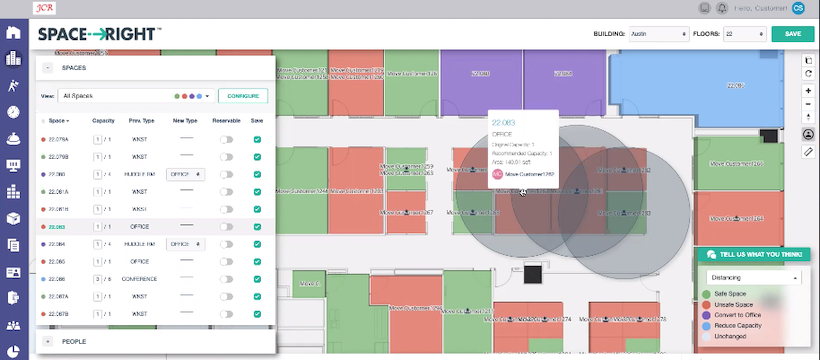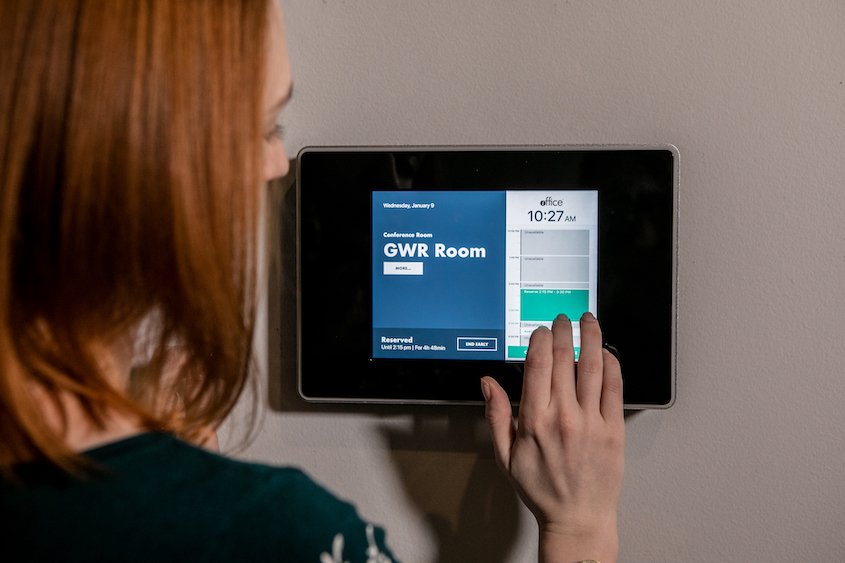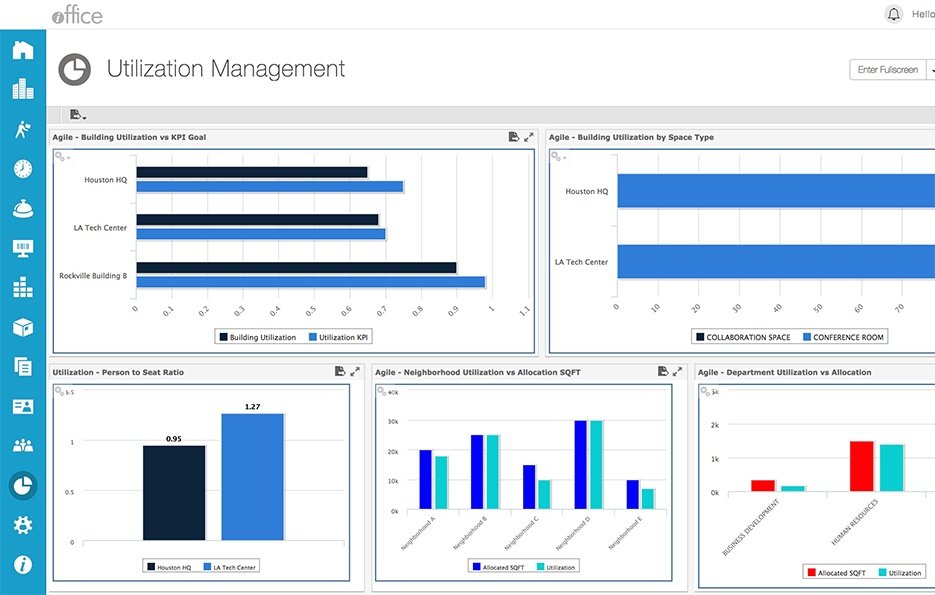How To Find The Best Facility Management Software


When you’re using the best facility management software, you have full transparency into your building operations and the ability to optimize them using your data.
You can easily see how every square foot of space is being used as you plan for the future.
You can see critical details on all your assets, track and schedule preventive maintenance, and manage cleaning efficiently and cost-effectively.
If you’re considering investing in facility management software in the coming year, look for these ten essential features.
10 features of the best facility management software
- Cloud-based
- Offers full visibility into your real estate portfolio
- Simplifies space management
- Allows for strategic planning
- Streamlines asset management and maintenance services
- Provides an exceptional workplace experience
- Has enterprise-level security
- User-friendly and mobile
- Offers robust reporting
- Integrates with sensors and emerging technology
Cloud-based
Cloud-based software should be a given these days, but many enterprises still struggle to break away from expensive, on-premise solutions. That’s understandable when they’ve invested so much into building and maintaining them over the years.
But to achieve the flexibility and scalability you need for continued growth, cloud-based facility management software is essential. Companies that adopt cloud-based platforms often see immediate savings from eliminating maintenance and upgrade costs, which are built into software-as-a-service (SaaS) subscription prices.
They also see a faster return on investment because these solutions require a minimal upfront investment.
Offers full visibility into your real estate portfolio
With so many organizations facing tough decisions about their office space — such as whether to consolidate, reconfigure, or expand to accommodate physical distancing guidelines — having easy access to information has never been more important.
The best facility management software makes it easy to see your company’s real estate from a 10,000-foot view and zoom in to a granular level. You should be able to see all properties, locations, occupancy levels, and costs at a glance. And when you need more detail, you should be able to see occupancy by building, floor, or department.
Simplifies space management

At the building level, facilities managers and workplace leaders often need to make immediate changes. That might include moving employees from a floor that’s filled to capacity across several different floors to allow for more distance between desks.
The best facility management software uses intelligent algorithms to align your office space with your changing needs. If you need to allow a distance of six feet or more between desks, it should be able to instantly reconfigure your floor plan based on those measurements. It should help you identify potentially unsafe spaces, such as desks that are too close together or areas that are too small for multiple people to occupy.
And it will make it easy to create different scenarios before you move a single piece of furniture. It will allow you to create move tasks and send email notifications to the appropriate people, which makes managing office moves a breeze.
See how Space-Right™ makes it easy to plan a safer workplace.
Allows for strategic space planning

Your enterprise needs to do more than adjust your office space in the moment. You also need to forecast future needs. With over 40% of your workforce planning to continue working remotely at least part-time for the foreseeable future, your office space needs six months from now may seem like a moving target. However, Gensler’s research shows the majority of employees do want to return to the office. In fact, 70% want to spend three to five days there during a typical week.
With the right technology and careful monitoring, it’s possible to get an accurate estimate of your office occupancy.
You can start by surveying your workforce to determine how many employees want to continue working remotely full-time or part-time after you reopen your office. Based on their responses, you may determine that a percentage of your employees no longer need dedicated desks. For those who do, you can use badge data, sensors, or office hoteling software to determine how often they use desks during a typical week.
The best facility management software allows you to capture that data and see it clearly within your floor plans. It also allows you to forecast your needs based on departmental growth.
Streamlines asset management and maintenance services
Your facility assets are just as critical to your operations as your buildings. That’s why your software should allow you to track and manage everything from your HVAC systems to your office printers.
It should keep records of lease terms to comply with FASB lease accounting standards and also allow you to track the total cost of ownership.
The best facility maintenance software also streamlines work order management and maintenance scheduling. Like asset management software, it lets you schedule preventive maintenance tasks based on dates or usage and notify you when it’s time to perform them.
Provides a safe, exceptional workplace experience

As a modern facility manager, you’re responsible for much more than buildings and assets. You’re fundamentally in charge of managing people and ensuring they have everything they need to stay safe and be productive.
That includes a comfortable environment, good lighting, and rooms or desks with the right equipment. The best facility management solution empowers employees to ask for what they need through a user-friendly workplace app. They should be able to find and reserve space, request service, and receive visitors or deliveries immediately.
Employees should also be able to find the nearest sanitization station, request additional cleaning, and be assured that someone will notify them if they have been exposed to coronavirus or another serious illness.
See how our return-to-work solutions simplify wellness checks and contact tracing.
Has enterprise-level security
The average cost of a data breach in 2020 was $3.86 million. That’s a scary number, and it doesn’t even include the cost of lost business and damage to your company’s reputation.
New data requirements, such as the General Data Protection Regulations (GDPR), mean companies need to take additional measures to protect customer data.
That includes using best-in-class security standards and supporting data encryption at rest.
User-friendly and mobile
Your facilities management team rarely sits still. You need to be able to access service requests, find assets, manage inventory, and more while you’re on the road or at the site of a repair.
That’s why the best software solutions include facility management apps.
From your mobile device, you can easily find the location of equipment that needs to be repaired, get detailed instructions for how to fix it, and mark it off your to-do list.
It should be easy for even the most technology-averse technicians to use with minimal training.
Offers robust reporting

The way facilities managers define success today has changed. There are greater expectations for ensuring the safety and wellbeing of the workforce. FMs are also expected to play a greater role in business strategy. And you can only do this if you have full visibility into the facility management metrics that matter most.
Your facility management software should make it easy for you to create dashboards and reports customized for different roles within your organization. Your CEO should be able to see a high-level overview of total building and maintenance costs, while your accountant and corporate real estate executive will need to see a more detailed analysis.
Your HR manager may want to see data that illustrates improvements in the workplace experience — for instance, how quickly you resolve employee service requests and IT help tickets. And your operations manager will want to see an overall reduction in equipment downtime.
The best solutions give everyone enough detail to measure success on their own terms, without making the process overly complicated.
Integrates with sensors and emerging technology
Sensors offer another layer of data that can help you better understand organizational performance and adapt to changes in real time.
For instance, occupancy sensors give you the most accurate information on which rooms and desks have been used on a daily, weekly, and monthly basis. You can gather a daily utilization report and adjust your cleaning schedule accordingly. You can also identify peak occupancy during the week and plan to have additional facilities team members working on those days. And based on trends over time, you may decide it makes sense to consolidate two underutilized floors or buildings, which could save you tens of thousands of dollars in the coming years.
While many companies are just beginning to tap into the potential of sensors, they are also exploring artificial intelligence, augmented reality, and other emerging technologies.
The best facility management software is built to integrate easily with these new solutions so your company can continue to innovate.
More than facility management software
iOFFICE recognizes facility management software has to evolve to meet the growing demands of the modern workplace. Today’s facilities managers aren’t just managing buildings; they’re managing an entire ecosystem of people, data, and technology.
That’s why our software is designed to be comprehensive, not complex.
It’s a system designed to place the workplace experience at the center and support positive business outcomes. It’s built to evolve and integrate easily with new technologies as they are introduced.
We call it the integrated experience management system (iXMS) because it’s built to support experiences and what Gartner calls “the continuous next.”
In other words, it’s designed to prepare your workplace for anything.
Ready to see a closer look? Request a live demo today.
